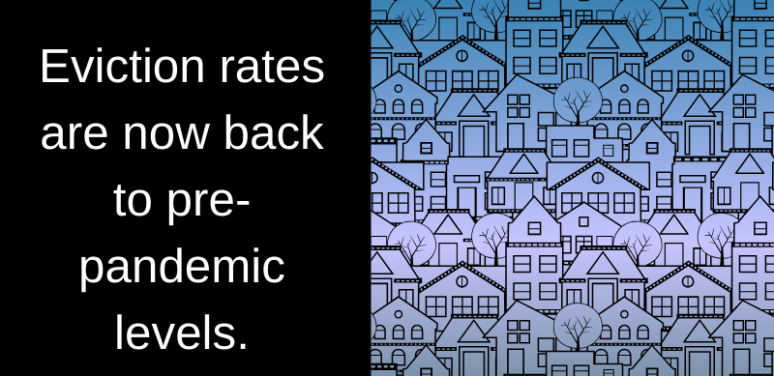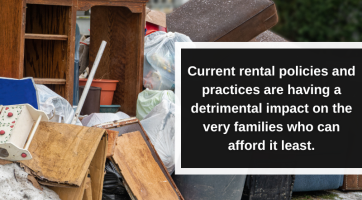Why can’t we get our arms around the eviction crisis?

by Steven McGarrity, executive director
Many things about our lives have gone back to where they were before the COVID-19 pandemic.
Family gatherings. Public events.
And evictions.
Nearly four years later, our eviction rates are now back to pre-pandemic levels.
And while there have been some attempts to address this decades-long crisis, our community lacks a broader vision of what it would mean – and look like – to solve what is a pandemic in its own right.
One outstanding idea that earned universal endorsement – from our local media, elected officials, housing advocates and landlords alike – was the idea of “right to counsel,” or ensuring that renters facing eviction had a lawyer to go through the court process with them.
While a right to counsel program in and of itself won’t solve the eviction crisis (Our community certainly could benefit from improved housing stock, greater availability of quality affordable and low-income housing, and permanent emergency rent assistance programs.), the concept has gained momentum in cities across the country. And for good reason, as this report from Cleveland captures.
But it isn’t just the outcomes that are well documented. The hallmarks of a successful program are, as well:
- A pilot phase providing a right to counsel should be based on geographic location or certain demographics (like families with children living below the federal poverty level), to ensure the people most negatively impacted by eviction benefit from the program.
- Eligible people need to know how to exercise their right to counsel. Court notices should be written in plain language so they know what’s happening, with clear instructions on how and when to reach out for help. We also need a public awareness campaign that drives this home, since it’s a change to long-standing practice where people don’t show up to court because they think they can’t possibly win. We need to change this mindset broadly.
- Any program should be tenant-centric, removing as many barriers as possible. This means minimizing the hoops people have to jump through, or the people they have to talk to, in order to get to an attorney. (This approach also maximizes efficiency and better use of the dollars invested for what they’re intended to do.)
- Courts practices need to accommodate a right-to-counsel program. Eviction proceedings historically move much faster than other legal proceedings. While landlords control the timeline and can prepare their case before filing, court timelines may need to be adjusted to give tenants and their attorneys time to adequately prepare for their day in court.
- Professionals taking these cases, just like our public defenders, need to be compensated in a way that means recruiting the best and brightest attorneys who have a public service mindset. They need adequate training and ongoing professional development, to ensure those eligible for the program receive the best representation possible.
- The actual representation tenants receive needs to be both consistent and complete. Eviction cases often have multiple parts: first, the court decides whether the renter can be evicted; then, the landlord can ask the court to order the renter to pay money they say they are owed by not paying rent or by damaging the unit. But like any lawsuit, the person being sued may have their own case against the other party – like if the landlord didn’t make needed repairs, they shouldn’t have owed as much rent as the landlord says they did. These are normal things that come up in the course of a lawsuit that lawyers need to have the time, space, and ability to work through.
These best practices, which have been deployed in cities like Cleveland, Boulder, Kansas City, and more, provide a footprint for northeast Ohio cities – many of which have some of the highest eviction rates in Ohio.
And the data on the impact is clear.
By reducing the number of people who are forcibly removed from their rental units (either because the eviction is denied and they get to stay, or because they get more time to find new housing), everyone in our community is better off – the kids in the family don’t have to deal with the disruption to their lives, education, and health. Our schools don’t have to grapple with transient or homeless students. Our social service agencies, which already are stretched, have fewer emergency cases to respond to. All these resources that people have to dip into when they are evicted, we can significantly reduce.
Eviction is a devastating consequence for a family. And every day Legal Aid attorneys make gut wrenching decisions on which families will get the benefit of representation in their eviction and which have to go it alone. Giving every family an opportunity to present their case to the court through an attorney is fair and just in a court system designed by and for attorneys. It also has the added benefit of being good for our community as a whole.
This article is part of Legal Aid’s “Big Ideas” series.
Sign up to get Big Ideas in your inbox
